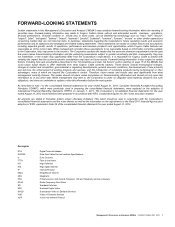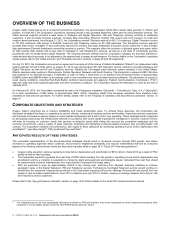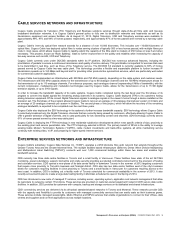Cogeco 2012 Annual Report Download - page 18
Download and view the complete annual report
Please find page 18 of the 2012 Cogeco annual report below. You can navigate through the pages in the report by either clicking on the pages listed below, or by using the keyword search tool below to find specific information within the annual report.Management’s Discussion and Analysis (MD&A) COGECO CABLE INC. 2012 17
resulting impact on service interruptions and mean time to restoration. In a technologically complex environment, the Corporation faces
growing challenges in preventing malware, hacking or other intrusions.
Electronic communications increasingly rely on advanced security technology, terminal devices, control systems and software to ensure
conditional access, appropriate billing and service integrity. Security and business systems technology is provided worldwide by a small pool of
global suppliers on a proprietary basis. As other providers of electronic communications, the Corporation depends on the effectiveness of such
technology for many of its services and the ability of technological solutions providers to offer cost-effective and timely solutions to deal with
security breaches or new developments required in the marketplace.
REGULATORY RISKS
In Canada, electronic communications facilities and services are subject to regulatory requirements depending mainly on the type of facilities
involved, the incumbent status of service providers and their relative market power, the technology used and whether the activities are
categorized as telecommunications or broadcasting. Canadian cable telecommunications facilities and services are subject to various
requirements, mainly under federal legislation governing broadcasting, radiocommunication, telecommunications, copyright, privacy and anti-
spamming, and under provincial legislation governing consumer protection and access to certain municipal electrical power utility support
structures. Broadcasting licences and broadcasting certificates are required for the operation of larger cable systems. Various licence and
licence exemption conditions apply in Canada. Canadian cable operators are also subject to Canadian ownership and control requirements.
Changes in the regulatory framework or licences, which are subject to periodic renewal, may affect the Corporation’s existing business
activities or future prospects.
The government of Canada has recently changed the requirements respecting the Canadian ownership and control of telecommunications
carriers. As a result of these changes, telecommunications carriers with less than 10% of market share in Canada may be owned and
controlled by non-Canadians. This change may lead to additional competition from new industry players in Canada or to more investment and
financial resources coming from non-Canadian investors in support of the competitive activities of new entrants on the telecommunications
market in Canada.
On September 21, 2011, the CRTC issued a new broadcasting regulatory policy dealing with the issues arising from vertical integration in the
industry. The CRTC has decided to prohibit companies from offering television programs on an exclusive basis to their mobile or Internet
customers and to make programs available on television also available to competitors under fair and reasonable terms. The CRTC also
adopted a code of conduct to prevent anti-competitive behaviour. In order to protect Canadians from losing a television service during
negotiations, broadcasters are required to continue providing the service to distributors, and distributors must continue to offer it to their
subscribers. The CRTC adopted earlier this year amendments to the Broadcasting Distribution Regulations as well as to other regulations and
orders in order to implement the new vertical integration framework. Based on initial experience with complaints and dispute resolution
following the announcement of this framework, management is of the view that the level of vertical integration within the Canadian broadcasting
system is such that the opportunity and the incentive for abuse of dominant position remains a concern in the Canadian downstream television
distribution market.
On March 16, 2012, Bell, the largest Canadian communications company, announced that it had concluded an agreement to acquire Astral
Media Inc, (“Astral”), the largest remaining Canadian independent programming service supplier subject to requisite regulatory approvals.
Based on the view that this transaction, if authorized by the CRTC and the Commissioner of Competition, would significantly increase the level
of vertical integration in the Canadian broadcasting and communications industries and compound the opportunity and incentive for abuse of
dominance, the Corporation strongly opposed this proposed transaction. Following a public hearing held in early September of this year, the
CRTC decided on October 18, 2012 to deny the proposed transaction in its entirety.
In Broadcasting Regulatory Policy CRTC 2010-167, the CRTC proposed to establish a value-for-signal (“VFS”) regime providing the right for
Canadian private local television stations to opt for either continued regulatory protection for the carriage of their signal and simultaneous
program substitution by BDUs, or the negotiation of compensation for the value of the distribution of their service by BDUs with the possibility
to require deletion on all other distributed signals of all programs for which they have respectively acquired exclusive contractual exhibition
rights. Concurrently with this policy announcement, the CRTC issued Broadcasting Order CRTC 2010-168 referring a question to the Federal
Court of Appeal on the CRTC’s authority under the Broadcasting Act to establish the proposed VFS regime. The Federal Court of Appeal, by
majority decision, ruled that the CRTC had the statutory authority under the Broadcasting Act to implement the VFS regime. On September 29,
2011, the Corporation obtained leave to appeal this decision to the Supreme Court of Canada, and the appeal was heard on April 17, 2012.
The Supreme Court of Canada has yet to issue its final judgment on this matter. Should it be confirmed and left unchanged, the VFS regime
would further enhance the bargaining power of large vertically integrated broadcasting groups in obtaining higher wholesale fees from
independent BDUs and Canadian customers to broadcasting distribution services.
In another reference initiated by the CRTC, the Supreme Court of Canada ruled that the transmission of program content by ISPs through
Internet service connections does not constitute broadcasting and cannot therefore be regulated by the CRTC under the Broadcasting Act.
























